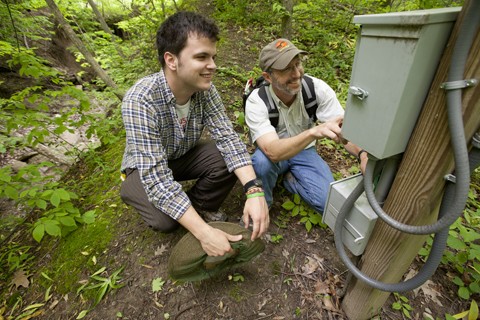Rain, Rain, Rain

Courtesy Amanda Pitts
Jul 14, 2011
For many West Michiganders, the past month has been plagued by bouts of heavy rainfall that have cancelled plans, flooded basements and made for miserable morning commutes. Tack on some severely damaged buildings, stalled construction and heavy levels of erosion to the Little Mac Ravines, and you’re seeing eye-to-eye with Grand Valley State University’s Allendale campus.
“All of the projects are affected by rain, the ones with longer durations are easier to manage,” said James Moyer, vice president of facilities planning. “The projects with the shorter durations are always a challenge.”
Since GVSU is located on land with a heavy concentration of clay material, the wet weather has caused difficulties for some projects, namely the student recreation fields project, which Moyer said has always had critical time elements and due to the exterior nature of the project is the most subject to weather.
“The water slowed us down a bit, it caused some re-work,” Moyer said. “All of the contractors are working through contingency plans to correct their schedules. Most of the initial restoration and cleanup activities are approaching completion.”
Many campus facilities were hit with power outages and flooded basements, but Lake Michigan Hall may have taken the brunt of the beating with not only flooding and power outages, but also damaged files and doors that were busted in by the force of the rain.
However, vice president for facilities services, Tim Thimmesch, said the damages at Lake Michigan Hall have already been restored and clean up was complete within the first few days of the incident. He said most of the departments with files that were damaged determined they did not need to retain many of the records, which were then shredded. Files that were necessary to maintain are being dried and returned to the appropriate storage.
Thimmesch said nothing was damaged that would compromise the records or documents for students or faculty returning this fall.
“I truly appreciated the support and cleanup efforts from all departments that were affected by the storm water last week,” he said. “Everyone simply pitched in, assessed the damage to their records or equipment that was stored and helped to determine what we needed to maintain or what could be discarded. The recovery effort and turn around went very well as a result of the contributions of many.”
Associate professor of geology, Peter Wampler, has been working with two students to collect runoff samples from the Little Mac ravine before and after the library construction project, collecting Total Suspended Sediment samples with a robotic sampler that is programmed to take samples during rain events. The samples are then analyzed in a lab to determine the amount of sediment being carried at a given time.
In the June 21 rain event, one of the larger storms GVSU has been dealt this summer, Wampler found the water went from base level to over 1.6 meters in less than an hour – that’s 1,500 gallons of water per second and something Wampler said has caused massive sediment wash out and erosion in the Little Mac Ravines.
Wampler said the June 21 rainstorm was a more extreme event, which doesn’t necessarily make for a fair representation. But by collecting the data in an array of events – of which the team has 12 currently – they hope to capture a more accurate snapshot of before and after the Storm Water Initiative.
To read more about GVSU’s Storm Water Initiative, visit http://www.gvsu.edu/stormwater/.






















